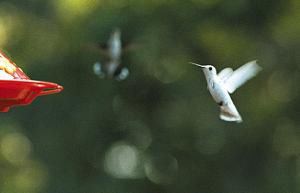|
home: www.rubythroat.org |
|
|
home: www.rubythroat.org |
|

Photo by Kathleen Flynn © Anderson (SC) Independent-Mail
Photo and article may NOT be duplicated without express written permission of the publisher.
A hummingbird innocently sipping homemade nectar from a bird feeder at Claude Hawkins' house on Bryant Road in Anderson County has caused a small stir.
The teeny bird, of the ruby-throated variety, has attracted the attention of a York hummingbird researcher because of a rare and striking characteristic: It is white except for a bit of dark coloring in its beak, eyes and claws.
"It's definitely leucistic!" an excited Bill Hilton Jr. said in a telephone interview after seeing photographs of the bird. The term refers to a lightly colored animal as opposed to a truly rare albino version, which this bird is not.
On Thursday evening Mr. Hilton drove to Anderson to trap the bird so that it could be banded and released for further study among researchers up and down the hemisphere. With a pull-string trap, he lured the bird in after a two and a half hour wait.
As he held the bird in his hand, he put a spot of green dye on its breast so that future birders would refrain from recapturing it.
"It is a young bird," Mr. Hilton said of the small female. "It hatched out this year."
About 100 white hummingbirds of various species have been reported in the United States since 1865, about 30 percent of them in the last 15 years, said Mr. Hilton, a science educator and nature writer with the Hilton Pond Center for Piedmont Natural History in York.
The leucistic female he banded Thursday was among only about a half dozen that have been banded in history, he said. The coloring makes the bird a prize because it is more likely to be noticed as it migrates.
"It's a white flag," he said. "It gives us an edge."
True albinos, including humans, have pink eyes and no pigmentation on their bodies. Normal male ruby throats have iridescent green backs, blackish heads with a white neck band and, of course, a red throat. Normal females are more plain.
Abnormal coloring is good for scientists, but unfortunate for animals, experts say.
"It's a bad thing," said Mary Bunch of the state Department of Natural Resources wildlife office in Clemson. "It's more apt to be eaten."
Also, mutations in coloring might be accompanied by other genetic problems and offer no extra protection to species under state or federal law, she said.
But if this bird helps scientists understand migration, better protection for the whole species can be devised, Mr. Hilton said.
Mr. Hawkins, a retired farmer, said his visiting son first noticed the unusual bird last Saturday at the feeder outside his kitchen window. It has fed regularly at his two feeders with several other ruby throats ever since.
The birds migrate north from South America and pass through this area as early as June but usually in July, said Ernest Locke of the Clemson Cooperative Extension Office in Anderson. They stay in one place as long as there is food and the temperature is right. [NOTE: Ruby-throated Hummingbirds spend the winter as far south as Central America, but not South America. They arrive in South Carolina as early as late March, not June and July.)
No hummingbirds live year-round in South Carolina, he said.
Actually, little else is known about their migration patterns, Mr. Hilton said, which is why he got a permit and began banding them in 1984. He trapped and banded his 1,000th bird last week, he said. [NOTE: The number should be 2,000.]
"They're easy animals to attract," Mr. Locke said. Four cups of water mixed with one cup of sugar and a bright red feeder is all it takes. The syrup can be dyed red, but it isn't necessary.
Back to "Albino" (Leucistic) Hummingbird Banded by Operation RubyThroat Director
Back to Hummingbird Articles
Back to Top of Page
|
Make direct donations on-line through
Network for Good: |
 |
|
LIKE TO SHOP ON-LINE?
Donate a portion of your purchase price from 500+ top on-line stores via iGive: |
|
|
Use your PayPal account
to make direct donations: |
|
|
|
Share Your Hummingbird Experiences Through "Hummingbird Hobnob" |
 |
Operation |
|
|